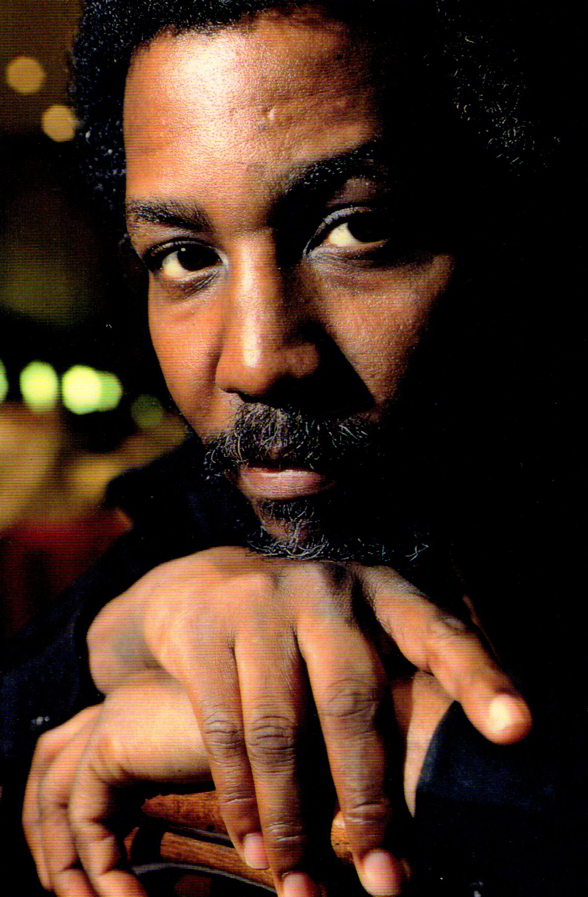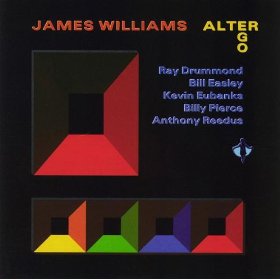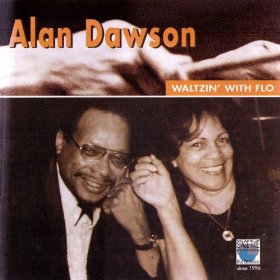Havana Days – Donald Brown
A modern uptempo Latin with mostly modal changes. The solo form is longer than the head.
- Recording: James Williams - Alter Ego
- Recorded on: July 19-20, 1984
- Label: Sunnyside (SSC 1007)
- Concert Key: C
- Vocal Range: , to
- Style: Latin/swing (medium up)
- Soprano Sax - Billy Pierce
- Alto Sax - Bill Easley
- Guitar - Kevin Eubanks
- Piano - James Williams
- Bass - Ray Drummond
- Drums, Percussion - Tony Reedus
0:00
0:00
Buy MP3
Video
- Description
- Historical Notes
- Solos
- Piano Corner
- Bass Corner
- Drum Corner
- Guitar Corner
- Inside & Beyond
- Minus You
This composition combines a classic Afro-Cuban vamp with a mostly modal, swinging theme. The vamp is played as an intro; the horns come in with a rhythmic figure on the last 16 measures. For the melody, composer Donald Brown changes the harmonic direction entirely with moving cluster voicings in the piano while the bass has its own line that goes along with the melody. All of this is notated in the Concert Condensed Score, which is the recommended part for all rhythm section players.
The head is repeated twice; the A section is 16 measures long, while the B section is 10 measures the first time and 8 the second time.
Though the harmonic relationships are not blues-like, it feels like a blues variant due to the transposition of the same melody from the first eight measures into the second eight. The faster harmonic motion of the B section thus feels like the "turnaround" of the blues.
The solo changes are quite intricate, so the Solos section is included on every edition. The form for the solos includes 16 measures of the vamp from the intro, followed by the changes of the head. These sections are followed by 20 more measures, mostly modal four-measure sections with the third of these being another "turnaround." Altogether the solo form is 60 measures long: letters C (16 measures), D (20), E (16), and F (8). The drum solo is on the vamp from the intro (after the other soloists). After the head out, the rhythmic figure from the intro is played as a coda. This is written out in the lead sheets, but in the Concert Condensed Score the ending is indicated by a double Dal Segno at the end of the head, leading back to the intro and the fine. This was done to avoid an extra page, which would make the part very music-stand unfriendly!
Pianists should check out Donald's Solo Piano Arrangement, to see how great this composition will also work for solo piano.
The Concert Condensed Score contains piano voicings, as recorded, that fill in the longer melody notes. The voicings for the two measures before the B section are taken from Richard Wyands' voicings on the James Spaulding recording; for voicings here more like what James Williams and Donald Brown played, check out the Piano Corner for the Solo Piano Arrangement.
The head is repeated twice; the A section is 16 measures long, while the B section is 10 measures the first time and 8 the second time.
Though the harmonic relationships are not blues-like, it feels like a blues variant due to the transposition of the same melody from the first eight measures into the second eight. The faster harmonic motion of the B section thus feels like the "turnaround" of the blues.
The solo changes are quite intricate, so the Solos section is included on every edition. The form for the solos includes 16 measures of the vamp from the intro, followed by the changes of the head. These sections are followed by 20 more measures, mostly modal four-measure sections with the third of these being another "turnaround." Altogether the solo form is 60 measures long: letters C (16 measures), D (20), E (16), and F (8). The drum solo is on the vamp from the intro (after the other soloists). After the head out, the rhythmic figure from the intro is played as a coda. This is written out in the lead sheets, but in the Concert Condensed Score the ending is indicated by a double Dal Segno at the end of the head, leading back to the intro and the fine. This was done to avoid an extra page, which would make the part very music-stand unfriendly!
Pianists should check out Donald's Solo Piano Arrangement, to see how great this composition will also work for solo piano.
The Concert Condensed Score contains piano voicings, as recorded, that fill in the longer melody notes. The voicings for the two measures before the B section are taken from Richard Wyands' voicings on the James Spaulding recording; for voicings here more like what James Williams and Donald Brown played, check out the Piano Corner for the Solo Piano Arrangement.
The complete name of this composition is Havana Days (Cuba 1954). This first recording comes from James Williams' first Sunnyside album, "Alter Ego." Havana Days is one of two Donald Brown compositions on the album; the other is Waltz For Monk (available as a combo publication). Also on this album are Williams' songs Beauty Within, A Touching Affair, and Alter Ego.
James Williams was a real champion of Donald Brown's music, and he recorded Donald's two compositions on this album before Donald got to record any of his own marvelous compositions.
There is auxiliary percussion (clave and cabasa) on Havana Days that is uncredited. We are assuming they were overdubbed by drummer Tony Reedus, or one of the other musicians on the date. James Williams' next album from the following year, "Progress Report", with almost the same band, also adds extra percussion for a Donald Brown song, Episode From A Village Dance; in that case it was credited to trumpeter and percussionist Jerry Gonzalez.
James Williams was a real champion of Donald Brown's music, and he recorded Donald's two compositions on this album before Donald got to record any of his own marvelous compositions.
There is auxiliary percussion (clave and cabasa) on Havana Days that is uncredited. We are assuming they were overdubbed by drummer Tony Reedus, or one of the other musicians on the date. James Williams' next album from the following year, "Progress Report", with almost the same band, also adds extra percussion for a Donald Brown song, Episode From A Village Dance; in that case it was credited to trumpeter and percussionist Jerry Gonzalez.
Solo Piano Arrangement Listen to the Solo Piano Arrangement, as played by Kenny Drew, Jr. [clip]. Kenny plays four-note voicings for the rhythmic figures on the intro vamp. The melody of the A section is played by both hands, mostly two octaves apart with the left hand going to the root on the longer notes. The fill chords are caught by the right hand until four measures before B, in which they are two-handed. The right hand occasionally harmonizes the melody in the B section with third-based voicings.
Related Songs
Email Send Havana Days to a friend
Send this page to a friend via email. Add your name or email in the first field. In the second, add one or more email addresses, separated by a comma.
- Recording: Alan Dawson - Waltzin' With Flo
- Recorded on: December 13, 1992
- Label: Space Time (BG 9808)
- Concert Key: C
- Vocal Range: , to
- Style: Latin (medium up)
- Trumpet - Bill Mobley
- Soprano Sax - Billy Pierce
- Tenor Sax - Andy McGhee
- Piano - Donald Brown
- Bass - Ray Drummond
- Drums - Alan Dawson
0:00
0:00
Buy MP3
Video
- Description
- Historical Notes
- Solos
- Piano Corner
- Bass Corner
- Drum Corner
- Guitar Corner
- Inside & Beyond
- Minus You
The arrangement on this recording is essentially identical to the original James Williams version (click on the "Alter Ego" album cover above). It is interesting to compare the combined timbres of the melody instrument lineups on these two recordings. The soprano sax sound cuts through well in both, though it is on top (above alto sax and guitar) in Williams' instrumentation whereas here it is sandwiched between the trumpet and tenor sax. Drummer Alan Dawson plays a different Latin groove, almost calypso-like; he also takes a longer solo over the vamp.
Alan Dawson, one of the founding faculty of the Berklee School of Music, appears on countless recordings but did not record any other albums as a leader. This album's lineup is closely related to that of James Williams' "Alter Ego" which contains the original version of this song. In addition to Billy Pierce and Ray Drummond, James Williams plays piano on five of the nine songs (the composer Donald Brown plays on Havana Days.). Three of these feature Dawson on vibes with Tony Reedus playing drums; the rhythm section is thus the same as on "Alter Ego."
Solo Piano Arrangement Listen to the Solo Piano Arrangement, as played by Kenny Drew, Jr. [clip]. Kenny plays four-note voicings for the rhythmic figures on the intro vamp. The melody of the A section is played by both hands, mostly two octaves apart with the left hand going to the root on the longer notes. The fill chords are caught by the right hand until four measures before B, in which they are two-handed. The right hand occasionally harmonizes the melody in the B section with third-based voicings.
Related Songs
Email Send Havana Days to a friend
Send this page to a friend via email. Add your name or email in the first field. In the second, add one or more email addresses, separated by a comma.
- Recording: James Spaulding - Smile Of The Snake
- Recorded on: December 3-4, 1996
- Label: HighNote (HCD 7006)
- Concert Key: C
- Vocal Range: , to
- Style: Latin (medium up)
- Flute - James Spaulding
- Piano - Richard Wyands
- Bass - Ron McClure
- Drums - Tony Reedus
0:00
0:00
Buy MP3
Video
- Description
- Historical Notes
- Solos
- Piano Corner
- Bass Corner
- Drum Corner
- Guitar Corner
- Inside & Beyond
- Minus You
This recording shows how well the song works in a quartet format, with the piano filling in some of the horn voicings from the sextet arrangement. James Spaulding personalizes the melody a little: in the second measure of B he holds out the first note (D) for beat 1, omitting the following C.
The bass and drums play a slightly different Latin groove from the first recording. The bass line on the second and fourth measures moves the G to the "and" of beat 3 (not beat 2), with the C on the downbeat of the following measure. The drum groove is not as syncopated on the second and fourth measures, to fit with a "2-3" clave.
The rhythmic figures from the intro also appear here after the drum solo, before the head out (which is played only once).
Note from Don Sickler, producer of the recording:
James Spaulding loved Donald Brown's music, and he recorded two of Donald's compositions on this recording. Sometimes, in a jazz ensemble context, traditional Latin vamps (that always land on the 4th beat of the bar), don't always settle right. That was the case at this recording session, so we elected to make it a two-measure vamp figure that locked in immediately. The lesson here is, if something doesn't lock in and feel right, figure out another solution. Or, don't try to perform the arrangement.
The bass and drums play a slightly different Latin groove from the first recording. The bass line on the second and fourth measures moves the G to the "and" of beat 3 (not beat 2), with the C on the downbeat of the following measure. The drum groove is not as syncopated on the second and fourth measures, to fit with a "2-3" clave.
The rhythmic figures from the intro also appear here after the drum solo, before the head out (which is played only once).
Note from Don Sickler, producer of the recording:
James Spaulding loved Donald Brown's music, and he recorded two of Donald's compositions on this recording. Sometimes, in a jazz ensemble context, traditional Latin vamps (that always land on the 4th beat of the bar), don't always settle right. That was the case at this recording session, so we elected to make it a two-measure vamp figure that locked in immediately. The lesson here is, if something doesn't lock in and feel right, figure out another solution. Or, don't try to perform the arrangement.
Produced by jazzleadsheets.com's Don Sickler, this album also contains two songs by pianist Richard Wyands including Yes It Is. This is the only album with Spaulding alongside any of the other players. We'll be exploring more music from this album in the future.
Solo Piano Arrangement Listen to the Solo Piano Arrangement, as played by Kenny Drew, Jr. [clip]. Kenny plays four-note voicings for the rhythmic figures on the intro vamp. The melody of the A section is played by both hands, mostly two octaves apart with the left hand going to the root on the longer notes. The fill chords are caught by the right hand until four measures before B, in which they are two-handed. The right hand occasionally harmonizes the melody in the B section with third-based voicings.
Related Songs
Email Send Havana Days to a friend
Send this page to a friend via email. Add your name or email in the first field. In the second, add one or more email addresses, separated by a comma.

Donald Brown
born on March 28, 1954
A lyrical pianist and prolific composer as well as a teacher, band leader and arranger, Donald Brown is considered one of the masters of contemporary jazz composition. Raised in Memphis, Tennessee, Donald studied trumpet and drums as a youth. It was not until he began studying at Memphis State University that he switched to piano as his primary instrument, the late start making his pianistic skill all the more incredible. Read more...
There was a problem.
...



